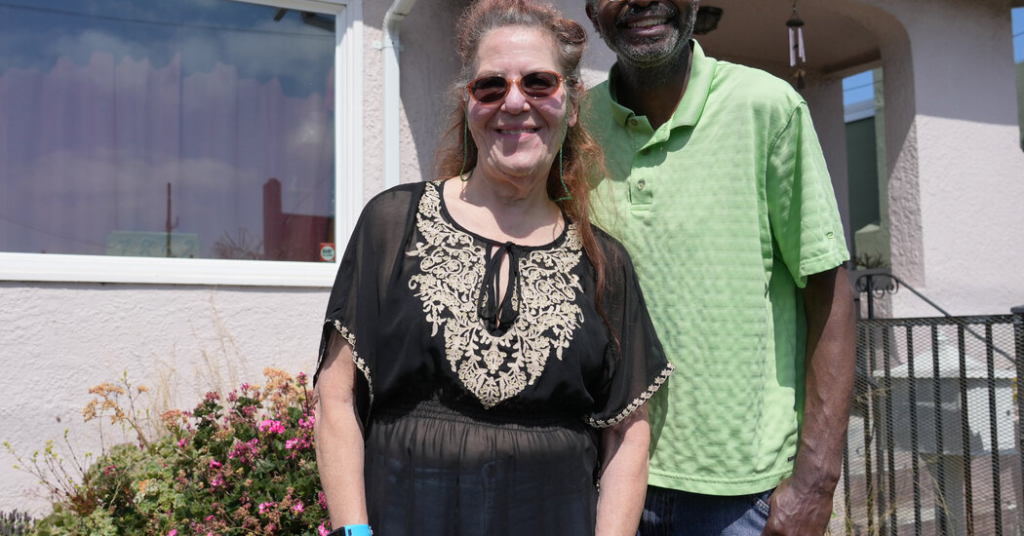Community Land Trusts in California Work to Create New … – The New York Times

Advertisement
Supported by
California Today
The state’s 30 or so land trusts sell houses at a discount, helping buyers who would otherwise be priced out.
Buying a house in California below the market sounds too good to be true.
But that’s exactly what Chris and Shekinah Samaya-Thomas did a few years back, paying $132,000 for a house that was valued at $166,000 (and that Redfin now estimates would go for about $545,000). The couple pulled off the purchase with the help of the Oakland Community Land Trust, which buys and sells houses at below-market prices, and assures that those properties remain affordable.
My colleague Claire Fahy recently wrote about this fascinating and unusual approach to addressing America’s worsening housing crisis, one that has been taking off in recent years.
Community land trusts, originally born of the civil rights movement, facilitate homeownership by selling houses at low prices, but with a catch: The trust retains ownership of the land under the house, and grants the buyer a 99-year lease on the land. Under this arrangement, when the homeowners want to move on, they can’t sell to just anyone; they must sell the house back to the land trust at a restricted price. Even so, they can still build up equity based on a resale formula that the trust provides.
There are now 315 community land trusts nationwide, up from 162 in 2006, Claire reports. Thirty or so are in California, in communities from Arcata to San Diego, and they’re working not just to create new homeowners but also to preserve their city’s character. In a twist on the usual model, a community organizer in the Leimert Park neighborhood of Los Angeles who is trying to slow gentrification even bought a commercial property recently, with plans to rent space to local businesses at below-market rates.
“People are casting a wider net, looking for more solutions for the housing crisis,” Claire told me. The trusts are popular, she said, because “people like them for the neighborhood preservation as well as for affordable housing — it kind of works for everyone in a way.”
Land trusts often buy houses that are in disrepair and then renovate them to be habitable. They receive funding through government programs, private investment and donations.
For some people, selling their homes to land trusts is a choice in line with their values and a way to support their communities.
In Point Reyes, north of San Francisco, Bobbi Loeb, 82, had a house that had appreciated to about $1 million. She was struggling with the cost of keeping up the property, but she was not sure she could afford anything else in the Bay Area.
So she sold the property for $500,000 to the Community Land Trust of West Marin under a deal that allowed her to stay in her house for the rest of her life, but without the responsibility of paying a mortgage or maintenance costs. And she knows her decision will one day help a lower-income family afford to live in the community where Loeb, a retired preschool teacher, has lived for decades.
“Till I die, I stay here,” she told Claire. “It’s a good deal. But they also got a great deal, because they bought my property for half what it’s worth.”
For more:
Read Claire’s article.
During the Hollywood strike, a Los Angeles diner has become a writers’ room of a different sort.
Student progress: Progress in math and reading stalled for elementary- and middle-school students in the U.S. last school year.
Affordable housing: Legislators and housing advocates want to curtail the California Coastal Commission’s power over affordable housing proposals, CalMatters reports.
Manson follower: Leslie Van Houten, a former Charles Manson follower who played a role in the murder of a Los Angeles couple in 1969, was released on parole after more than 50 years in prison.
Newsom’s inner circle: Gov. Gavin Newsom relies on a small group of advisers to help guide him. Here’s a breakdown of his inner circle from Politico.
Reparations: Conservatives are criticizing the state’s proposal to establish large-scale reparations for Black residents affected by the legacy of slavery, The Guardian reports.
SOUTHERN CALIFORNIA
Union-Tribune sale: The billionaire owner of The Los Angeles Times and The San Diego Union-Tribune has sold the San Diego paper to MediaNews Group, The Associated Press reports.
Hospital investigation: Cedars-Sinai Medical Center is being investigated for its treatment of Black women who give birth at the hospital, The Los Angeles Times reports.
CENTRAL CALIFORNIA
Hazardous fumes: Four Starbucks employees at the Fresno Yosemite International Airport were taken to a hospital after fumes from an apparent chemical leak made them sick, The Fresno Bee reports.
NORTHERN CALIFORNIA
Police settlement: A man who was left paralyzed after Yuba City police officers slammed him to the ground during a traffic stop won a $20 million settlement, The Associated Press reports.
Oakland mayor’s salary: Oakland’s budget proposal includes a $75,000 salary increase for Mayor Sheng Thao, while cutting spending in several departments, The San Francisco Chronicle reports.
Pension plans: The Biden administration allocated $1.16 billion to pension plans for automotive workers and retail clerks in the Bay Area, The San Francisco Chronicle reports.
Today’s tip comes from Grant Ferrier, who recommends a walk in San Diego:
“My favorite walk is about a three-mile beach walk from Torrey Pines State Natural Reserve to La Jolla Shores in San Diego County. Start along the flat beach break. Then the cliffs ride up on your left, and you may have to scramble around a couple of ledges, depending on the tide, to get to Black’s Beach. Hang gliders often circle above, and surfers abound on good wave days, as the beach opens up but is still sheltered by massive cliffs. As you near the pier for the Scripps Institution of Oceanography, you pass the iconic Mushroom House built on the beach.”
Tell us about your favorite places to visit in California. Email your suggestions to CAtoday@nytimes.com. We’ll be sharing more in upcoming editions of the newsletter.
What books would you put on a California reading list? What fiction or nonfiction best captures the Golden State, and why?
Email us at CAtoday@nytimes.com with your suggestions. Please include your name and the city where you live.
California’s Lavender Festival is in full bloom.
Eighty-five miles east of downtown Los Angeles, the Lavender Festival in Cherry Valley is open from 5 p.m. to 10 p.m. most days through July 23. Visitors can tour the lavender fields in a tractor-pulled wagon, shop at the vendor village or simply enjoy the serenity of the fields, The Los Angeles Times reports.
Thanks for reading. I’ll be back tomorrow. — Soumya
P.S. Here’s today’s Mini Crossword.
Briana Scalia, Maia Coleman and Sadiba Hasan contributed to California Today. You can reach the team at CAtoday@nytimes.com.
Sign up here to get this newsletter in your inbox.
Soumya Karlamangla is the lead writer for the California Today newsletter, where she provides daily insights and updates from her home state. More about Soumya Karlamangla
Advertisement


